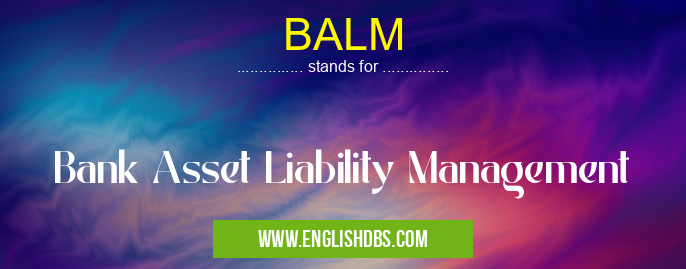What does BALM mean in BANKING
BALM stands for Bank Asset Liability Management and it is an important tool which helps banks to manage their finances effectively. It involves the management of different assets, liabilities, liquidity, and other capital sources in order to maximize a bank's overall profitability. BALM is used by many financial institutions such as investment firms, hedge funds, commercial banks, and insurance companies. It is also known as ALM (Asset Liability Management).

BALM meaning in Banking in Business
BALM mostly used in an acronym Banking in Category Business that means Bank Asset Liability Management
Shorthand: BALM,
Full Form: Bank Asset Liability Management
For more information of "Bank Asset Liability Management", see the section below.
Essential Questions and Answers on Bank Asset Liability Management in "BUSINESS»BANKING"
What is Bank Asset-Liability Management (BALM)?
Bank Asset-Liability Management (BALM) is a process used by banks and financial institutions to identify and manage the assets and liabilities of their portfolios. It involves setting risk limits, monitoring market trends, and analyzing portfolio behavior. The goal of BALM is to minimize the risk of losses while maximizing returns.
How does BALM help banks?
BALM helps banks by allowing them to optimize their assets and liabilities for maximum profitability. Through this process, banks can better understand their current risk exposure, as well as forecast potential risks in the future. Additionally, BALM can help identify opportunities for improved efficiency and cost savings.
Who manages BALM within a bank?
Typically, a Risk Manager or an asset-liability manager will be responsible for managing BALM within a bank or financial institution. However, other teams such as treasury management may also play an important role in determining strategic decisions that have an impact on a bank's balance sheet.
What are some common metrics used in BALM?
Common metrics used in BALM include liquidity ratios, interest rate sensitivity tests, gap analysis, duration gaps, capital adequacy assessments, leverage ratios, profitability ratios and concentration limits. These metrics provide an understanding of a bank's exposure to various risks associated with its particular portfolio mix.
How often should banks review their balance sheets using BALM?
Banks should review their balance sheets regularly using BALM principles in order to maintain a healthy balance sheet composition that will enable them to meet regulatory requirements and maximize returns. Generally speaking, balance sheets should be reviewed at least annually or when major changes occur such as acquisitions or divestitures.
What type of reports are generated from the implementation of BALM?
Reports generated from the implementation of BALM typically include balance sheet summaries with asset and liability characteristics such as loan return rates; time series comparisons of liquidity ratio changes over periods; gap analyses comparing expected rate sensitivities versus actuals; profitability analysis measures; capital structure assessment reports; credit ratings reports; stress test outcomes; concentration limits reports; etc.
What is gap analysis in regards to Bank Asset Liability Management (BALM)?
Gap analysis is a tool used within the framework of Bank Asset Liability Management (BALM) that allows an institution to understand how sensitive its assets are compared with its liabilities which includes expected changes in interest rates due to market fluctuations over time-periods specified in advance by regulators or internal policies . This helps institutions identify areas for improvement such as reducing the maturity mismatch between assets and liabilities or increasing diversification among available investments options.
What types of risks do Banks need to consider when undertaking Bank Asset Liability Management (BALM)?
Banks must consider several different types of risks during Bank Asset Liability Management (BALM). These include credit risk (the risk that borrowers will not repay loans), liquidity risk (the risk that banks may face difficulty selling their assets quickly enough at fair value), market risk (the risk caused by unforeseeable shifts in global markets), operational risk (the risk posed by inadequate systems processes and technology) , legal & reputational risks arising due to non-compliance with regulations etc.
Final Words:
Bank Asset Liability Management (BALM) plays an extremely important role in helping banks maintain a stable financial position while also increasing profits over time. Balancing assets with liabilities as well as properly assessing risks associated with those investments help ensure that the bank remains profitable while also protecting itself from unexpected losses due to market changes or fraud activity. Thus by utilizing these practices regularly; Banks are able to provide better services for customers while maintaining long-term financial stability at the same time!
